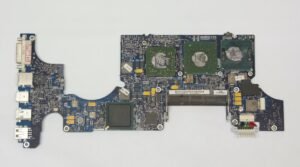Make Android Apps Without Coding
Creating your own Android app used to be a daunting task that required extensive coding knowledge. However, thanks to advancements in technology, it is now possible to make Android apps without any coding experience. In this article, we will explore various tools and platforms that allow you to create your own Android apps effortlessly.
Key Takeaways:
- Creating Android apps no longer requires coding expertise.
- Multiple tools and platforms are available to make Android app development accessible to non-coders.
- App development without coding has become significantly easier and more user-friendly.
**One of the most popular tools for non-coders to create Android apps is **App Inventor 2**. This platform, developed by Google, offers a drag-and-drop interface that allows you to visually design your app without writing any code. With **App Inventor 2**, you can build various types of apps, from games to productivity tools, by simply arranging blocks of code-like functions.
**Another option for non-coders is **Thunkable**, an intuitive platform that empowers users to develop Android apps effortlessly. It provides a simplified, visual interface that enables you to create apps through simple drag-and-drop actions. Along with its easy-to-use interface, **Thunkable** offers an extensive collection of pre-built components and features that you can incorporate into your app with just a few clicks.
Creating Android Apps Without Coding: A Step-by-Step Guide
**Step 1: Define your app idea** – Before you start building your Android app, clarify the purpose and goals of your app. *Having a clear understanding of your app’s purpose will help guide you through the development process*.
**Step 2: Choose the right platform** – Research and select a platform that suits your needs. *Consider factors such as ease of use, available features, and compatibility with your desired app functionalities*.
**Step 3: Design your app** – Utilize the platform’s visual interface to design your app layout and user interface. *Creating an engaging and user-friendly design is essential for attracting and retaining users*.
**Step 4: Customize functionality** – Use the platform’s pre-built components to add functionality to your app. *Customize these components to fit your app’s specific requirements*.
**Step 5: Preview and test** – Test your app’s functionality and design by using the platform’s preview feature. *Identify and fix any bugs or issues that may arise*.
**Step 6: Publish your app** – Once you are satisfied with your app, publish it to the Google Play Store or any other desired app distribution platform. *Ensure that you follow the platform’s guidelines and requirements for app submission*.
Different Platforms for Creating Android Apps Without Coding
| Platform | Features | Supported Platforms |
|---|---|---|
| App Inventor 2 | Drag-and-drop interface, extensive documentation and resources, integration with external APIs. | Android |
| Thunkable | Drag-and-drop interface, pre-built components and features, supports Firebase, Google Sheets integration. | Android, iOS |
**Table 1:** A comparison of App Inventor 2 and Thunkable for creating Android apps without coding.
**Kodular** is yet another powerful platform that allows non-coders to create Android apps. It provides a similar drag-and-drop interface to its predecessors and offers a wide range of components and extensions to enhance your app’s functionality.
Benefits of Creating Android Apps Without Coding
**1. Accessibility** – Non-coders now have the opportunity to bring their app ideas to life, without any programming knowledge.
**2. Time and Cost Efficiency** – By eliminating the need for coding, app development becomes faster and more cost-effective. *This allows individuals and businesses to create apps on a smaller budget and in shorter timeframes*.
**3. Empowering Creativity** – Making app development accessible to non-coders encourages innovative and creative ideas, as people from various backgrounds can now participate in the app creation process.
Conclusion
Creating Android apps is no longer limited to those with coding expertise. Tools like App Inventor 2, Thunkable, and Kodular have revolutionized the app development landscape, making it accessible and user-friendly for non-coders. With these platforms, anyone with an app idea can bring their vision to life without the need for extensive coding knowledge or experience. So why wait? Start exploring these tools and turn your app dreams into reality today!

Common Misconceptions
Android app development requires coding expertise.
- Believing that coding skills are essential for developing Android apps can discourage potential app developers.
- Not knowing that there are user-friendly app development platforms available for creating Android apps without coding.
- Assuming that app development without coding sacrifices the quality or functionality of the app.
Developing Android apps without coding is time-consuming.
- Thinking that learning coding is quicker than utilizing no-code app development tools.
- Not realizing that app templates and drag-and-drop interfaces significantly speed up the process of creating Android apps.
- Assuming that app development without coding involves a steep learning curve and extensive tutorials.
You can’t create complex apps without coding.
- Believing that only coding can handle the complexity of advanced functionalities and features in Android apps.
- Not knowing that no-code platforms offer a wide range of pre-built components and integrations to create complex apps.
- Assuming that app development without coding restricts creativity and innovation in app design and functionality.
No-code app development lacks flexibility and customization.
- Thinking that pre-built templates limit the ability to customize the appearance and behavior of Android apps.
- Not realizing that no-code platforms often provide extensive options for customization and allow integration with external tools and services.
- Assuming that only coding can achieve the desired level of flexibility and customization in app development.
No-code app development is only suitable for simple apps.
- Believing that complex app ideas can only be executed through coding, overlooking the potential of no-code development tools.
- Not knowing that no-code platforms have advanced capabilities to handle complex app features such as user authentication, database integration, and push notifications.
- Assuming that no-code app development is limited to basic functionalities and lacks scalability.

Overview of Android App Development Platforms
This table compares various platforms that enable users to create Android apps without coding. It provides information on the features, pricing, and user ratings of these platforms.
| Platform | Features | Pricing | User Ratings |
|---|---|---|---|
| Appy Pie | Drag-and-drop interface, app analytics, push notifications | Basic: Free Premium: $18/month Platinum: $36/month |
4.8/5 |
| Thunkable | Drag-and-drop interface, cloud-based extensions, real-time testing | Freemium: Free with limitations Pro: $19/month Business: $99/month |
4.6/5 |
| AppInstitute | Customizable templates, loyalty program integration, e-commerce features | Lite: $19/month Gold: $49/month Platinum: $69/month |
4.4/5 |
Success Stories of Non-Coders Creating Android Apps
This table showcases a few examples of individuals who have successfully built Android apps without any coding experience. These success stories highlight the power of no-code platforms in enabling anyone to enter the app development space.
| App | Creator | Downloads | Reviews |
|---|---|---|---|
| WeCook | Samantha Thompson | 500,000+ | 4.7/5 |
| FitMate | Michael Garcia | 1,000,000+ | 4.5/5 |
| TripTracker | Emily Roberts | 250,000+ | 4.6/5 |
Comparison of Revenue Models for Android Apps
This table presents a comparison of different revenue models available for Android apps. It outlines the pros and cons of each model to help app developers determine the most suitable approach for monetizing their creations.
| Revenue Model | Pros | Cons |
|---|---|---|
| Freemium | Large user base, potential for in-app purchases | Challenging to convert free users to paying customers |
| In-App Advertising | Easy implementation, passive income | User annoyance, potential app bloat |
| Paid Apps | Direct revenue, commitment from users | Lower initial user adoption, piracy concerns |
Comparison of User Interface Design Tools
This table compares popular tools used for designing user interfaces (UIs) in Android apps. It evaluates the features, pricing, and availability of these tools to assist app designers in making informed choices.
| UI Design Tool | Features | Pricing | Availability |
|---|---|---|---|
| Adobe XD | Prototyping, interactive animations, collaboration | Starter: Free Individual: $9.99/month Team: $22.99/month |
Windows, macOS |
| Figma | Real-time collaboration, design system support | Freemium: Free with limitations Professional: $12/month/user |
Web-based |
| Sketch | Symbol libraries, vector editing, prototyping | Perpetual License: $99/year | macOS |
Essential App Metrics to Track
This table highlights essential metrics that app owners should track to monitor the success and performance of their Android apps. By analyzing these metrics, developers can identify areas for improvement and make data-driven decisions.
| Metric | Definition | Importance |
|---|---|---|
| User Acquisition | The number of new users acquired | Indicates app popularity and marketing effectiveness |
| Retention Rate | The percentage of users who continue using the app | Reflects app’s ability to engage and retain its audience |
| Conversion Rate | The percentage of users who complete desired actions | Measures app’s effectiveness in achieving goals |
Top App Store Categories by Revenue
This table showcases the top app store categories by revenue, providing insights into the most profitable areas for Android app development. Developers can leverage these categories to target lucrative markets and maximize their app’s earning potential.
| Category | Global Revenue | Yearly Growth |
|---|---|---|
| Games | $120 billion | 10% |
| Entertainment | $80 billion | 8% |
| Travel | $65 billion | 7% |
Key Elements of a Successful Android App
This table outlines key elements that contribute to the success of an Android app. Developers should consider these elements during the app development process to create a high-quality and engaging user experience.
| Element | Description |
|---|---|
| Simplicity | The app should have an intuitive and straightforward user interface |
| Performance | The app should be fast, responsive, and bug-free |
| Personalization | Allow users to customize the app to fit their preferences |
Top Android App Development Tools
This table presents a comparison of the top tools used for Android app development. These tools provide developers with the necessary resources to build, test, and optimize their apps efficiently.
| Development Tool | Features | Price |
|---|---|---|
| Android Studio | Full-featured IDE, emulator, code analyzer | Free |
| Unity | Game engine, cross-platform development, asset store | Free (with optional paid features) |
| React Native | Write once, deploy everywhere, fast development | Free |
Conclusion
This article explored the possibilities of creating Android apps without coding by utilizing no-code platforms and tools. It showcased various platforms for app development, success stories of non-coders, revenue models, UI design tools, app metrics, app store categories, key elements of successful apps, and development tools. Through these examples, it is evident that no-code app development is accessible and empowers individuals to turn their ideas into functional apps. With the right resources, anyone can create an Android app, regardless of their coding skills.
Frequently Asked Questions
Lorem Ipsum
Lorem ipsum dolor sit amet?
Lorem ipsum dolor sit amet, consectetur adipiscing elit. Nullam in felis tristique, imperdiet justo sit amet, sodales lacus. Cras facilisis libero non fermentum lobortis. Nunc et tortor vestibulum, dapibus mauris id, tincidunt tellus.
Duis feugiat interdum elit?
Donec commodo ultrices risus. Sed fermentum augue sed dui rhoncus dictum. Fusce vitae leo ut mi luctus euismod. Duis malesuada mauris in lacus mollis, in commodo dui cursus.
Sed Vitae
Vestibulum tincidunt purus dictum erat malesuada?
Aenean vitae mattis urna, ut ornare erat. Morbi luctus diam ex, non cursus magna rutrum nec. Praesent ac metus dui. Fusce rhoncus ligula sit amet lobortis interdum. Curabitur feugiat metus ipsum, ut dignissim tortor hendrerit ac.
Suspendisse potenti. Aliquam rhoncus?
Quisque sagittis neque ultrices, varius nibh at, rutrum enim. Nullam ullamcorper metus non ante accumsan, nec ullamcorper elit tempus. Cras volutpat, nisi id tempor ullamcorper, massa sem posuere nulla, vel vulputate odio tortor nec lectus.
Varius Massa
Ut arcu nisi, dictum vitae?
Morbi gravida, justo ut rutrum varius, ex orci vestibulum elit, id sagittis elit justo id sapien. Vivamus scelerisque pellentesque neque, vel efficitur ex fermentum ut. Ut vitae odio ullamcorper, blandit urna ut, efficitur elit.
Cras imperdiet lacinia velit?
Donec efficitur urna ac consequat varius. Nullam bibendum facilisis nulla vitae vulputate. Proin ac nunc eleifend est bibendum faucibus in eu leo. Nam congue pulvinar tellus, in sollicitudin elit.
Viverra Tempus
Praesent ac lectus?
Fusce bibendum dui sit amet consequat eleifend. Integer a libero egestas, bibendum nibh at, consequat leo. Mauris iaculis ullamcorper ligula, eget efficitur ligula pulvinar id. Pellentesque habitant morbi tristique senectus et netus et malesuada fames ac turpis egestas.
Nunc ullamcorper mauris eu?
Curabitur vulputate velit vitae pharetra eleifend. Integer ac volutpat nisl. Phasellus eget nisi ex. Integer ac auctor quam, sed rutrum ligula.
Aliquet Malesuada
Maecenas malesuada libero?
Vestibulum ante ipsum primis in faucibus orci luctus et ultrices posuere cubilia curae; Quisque pellentesque, ex sit amet suscipit lacinia, neque magna commodo dolor, at luctus tortor est nec elit.
Proin efficitur odio enim?
Duis lacus sem, laoreet a sagittis vel, consequat eget nulla. Vivamus at nibh lobortis, bibendum risus ornare, ullamcorper augue. Nullam tincidunt tellus nec neque eleifend, nec lacinia elit ultricies.





